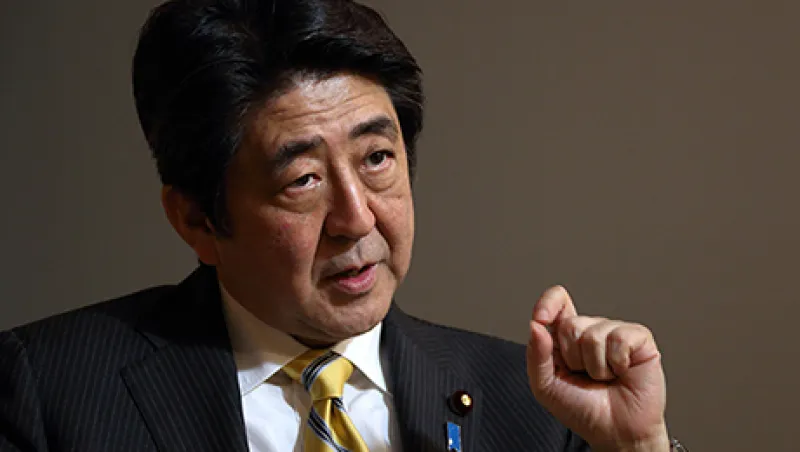In Japan, women who try to follow the advice of Facebook chief operating officer Sheryl Sandberg and “lean in” to the corporate world often find themselves up against a brick wall. Japanese society is built on the premise that men work double-digit-hour shifts and women stay at home. Prime Minister Shinzo Abe says he is determined to overhaul this state of affairs in the name of reviving the country’s growth rate.
The country’s economic problems have made Abe an ardent believer in women’s rights — at least in the workplace. In the past he has come under fire for denying that the Japanese government had a role in abducting the so-called comfort women in Asian countries occupied by Japan during World War II who were forced into prostitution and for pulling the Chrysanthemum Throne out from under young Princess Aiko, the first-born grandchild of ruling Emperor Akihito, after her male cousin was born, reversing a plan that would have allowed women to inherit the monarchy. But he subscribes to the view that Japan’s economy won’t grow unless more women are earning paychecks, and he has even launched a blog he called “SHINE! Toward a Japan Where All Women Can Shine” — although critics have pointed out that a Japanese speaker might read the word as “shi-ne,” the imperative of “die.”
On June 24 Abe came out with 230 proposals in his so-called third arrow of structural economic reforms. Among them were calls for measures to ease women’s access to the workplace, including an appeal to eliminate taxes that penalize married women who work; a new requirement that publicly traded companies would have to disclose the number of women holding executive positions; and a proposal to allow more foreign housekeepers to come into special economic zones of Japan, part of an effort to make it easier for Japanese women to get out of the house and go to work. And among those giving — or clicking, rather — a thumbs-up is Sandberg, whose bestselling book, Lean In, came out in Japanese translation last year and who has met with the Japanese premier.
Abe has also begun to deregulate day care centers, with the aim of adding 400,000 new facilities by 2017. Such government mandates can make the logistics of going to work easier for women. And the Japanese premier’s proposed quotas for women in corporate leadership positions can serve to remind male executives that the country has a gender diversity problem. Japan needs policy measures to bring more women into the workplace, but the corporate culture and society’s expectations also have to evolve, says Kathy Matsui, chief Japan equity strategist at Goldman Sachs Group’s global investment research division in Tokyo.
In a 1999 research paper, Matsui coined the term womenomics to describe the potential role that women could play in expanding Japan’s economy. Since then, she has continued to update her research, and Abe has cited her work in his policy speeches.
In her most recent study of womenomics, which came out May 30, Matsui presented findings from Tokyo-based financial publisher Toyo Keizai that might lure investors. In a study of 765 listed Japanese companies, those with the highest ratios of women managers had average returns on equity in excess of 10 percent over the three-year period from 2010 to 2012, whereas companies with the lowest percentage of women managers had returns of close to zero — or even negative. She also estimates that Japan’s GDP could rise by nearly 13 percent if the employment rate of women rose to match that of men.
The 2013 Global Gender Gap Report from the World Economic Forum, an annual country-by-country review of gender disparities based on economic, political, educational and health criteria, rates Japan 104th out of 136 countries in economic participation and 105th overall. Behind Japan on the list are South Korea and much of the Middle East. In a June report called Closing the Gender Gap in Japan, the WEF put the rate of female participation in the labor force at 63 percent, one of the lowest among OECD countries and 79th globally. (The male participation rate was 85 percent.) The WEF report also ranks Japan at 87th place in terms of the salary gap. And women make up only 2 percent of corporate boards and less than 1 percent of executive committees.
Japan is not without ambitious women who have been able to get ahead, as well as corporate leaders who are making an effort to promote more women. Teiko Kudo became the first woman to crack the senior management ranks at Sumitomo Mitsui Banking Corp. this spring. Carlos Ghosn, the CEO of French-Japanese automaker Renault-Nissan, has introduced quotas to encourage women to apply for senior-level jobs in Japan.
But barriers persist. In her latest report, Matsui cited a recent survey from Japan’s Ministry of Health, Labor and Welfare in which 50 percent of respondents said the main reason there are so few women in corporate management was “too few females with sufficient knowledge, experience and judgment.” As in the U.S., says Matsui, in Japan there is a shortage of women with technology-related degrees. She recommends that companies take several measures to address issues facing women in the workplace, including creating more flexible work environments so that work isn’t the 80-hour-a-week proposition that it is for men.
“The way Japanese men work isn’t much fun, and if you had the option, you wouldn’t want to work either,” says Rochelle Kopp, who runs Japan Intercultural Consulting, a Chicago-based training and consulting firm that works with Japanese business executives and foreigners doing business in Japan. “For some men, the hours have gotten even worse in the last few years; with the economic problems, they have less staff.”
But in fact there is a growing shortage of labor in a broad range of industries, and that might ultimately force businesses to recruit women and offer them sufficient salaries and work-life balance to stay on. Much of the shortage is because of a shrinking and aging population, yet only 63 percent of the women work. “We don’t have natural resources in Japan,” says Matsui. “Our top resource is people, and you don’t have a lot of options unless you tap into half of your population.”






